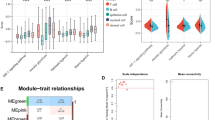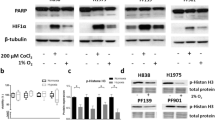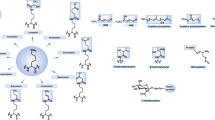Abstract
We have developed a hypoxia-inducible gene therapy approach for the expression of the mature form of human endonuclease G to facilitate cell death in hypoxic regions of the tumor. The chimeric therapeutic gene is placed under the control of a hypoxia response element based promoter and contains a translocation motif linked in frame to an oxygen-dependent degradation domain and the endonuclease G gene. Transient expression of the chimeric therapeutic gene in breast and prostate cancer cell lines resulted in efficient cell death under hypoxia-mimetic conditions. Stable MDA-MB-435 cells expressing the chimeric therapeutic gene under 1% O2 showed an increase in stable HIF-1α protein levels and synthesis of the endonuclease G protein in a time-dependent manner. In normoxic conditions, these stable transgenic cells exhibited no change in growth rate, invasion and motility when compared to parental cells. Moreover, xenografts generated using the transgenic cells exhibited highly significant suppression of tumor growth in a preclinical cancer model compared to the parental cell line. Thus, the hypoxia-modulated endonuclease G expression has the potential to be used as a gene-based-therapy system to kill malignant cells within hypoxic regions of tumors.
This is a preview of subscription content, access via your institution
Access options
Subscribe to this journal
Receive 12 print issues and online access
$259.00 per year
only $21.58 per issue
Buy this article
- Purchase on SpringerLink
- Instant access to full article PDF
Prices may be subject to local taxes which are calculated during checkout







Similar content being viewed by others
References
Sartorelli AC . Therapeutic attack of hypoxic cells of solid tumors: presidential address. Cancer Res 1988; 48: 775–778.
Ahn GO, Brown M . Targeting tumors with hypoxia-activated cytotoxins. Front Biosci 2007; 12: 3483–3501.
Boast K, Binley K, Iqball S, Price T, Spearman H, Kingsman S et al. Characterization of physiologically regulated vectors for the treatment of ischemic disease. Hum Gene Ther 1999; 10: 2197–2208.
Binley K, Iqball S, Kingsman A, Kingsman S, Naylor S . An adenoviral vector regulated by hypoxia for the treatment of ischaemic disease and cancer. Gene Ther 1999; 6: 1721–1727.
Koshikawa N, Takenaga K, Tagawa M, Sakiyama S . Therapeutic efficacy of the suicide gene driven by the promoter of vascular endothelial growth factor gene against hypoxic tumor cells. Cancer Res 2000; 60: 2936–2941.
Zhao HC, Zhang Q, Yang Y, Lu MQ, Li H, Xu C et al. p53-expressing conditionally replicative adenovirus CNHK500-p53 against hepatocellular carcinoma in vitro. World J Gastroenterol 2007; 13: 683–691.
Liu J, Harada H, Ogura M, Shibata T, Hiraoka M . Adenovirus-mediated hypoxia-targeting cytosine deaminase gene therapy enhances radiotherapy in tumour xenografts. Br J Cancer 2007; 96: 1871–1878.
Jeong CH, Lee YM, Choi KS, Seong YR, Kim YJ, Im DS et al. Hypoxia-responsive element-mediated soluble Tie2 vector exhibits an anti-angiogenic activity in vitro under hypoxic condition. Int J Oncol 2005; 26: 211–216.
Harada H, Kizaka-Kondoh S, Hiraoka M . Mechanism of hypoxia-specific cytotoxicity of procaspase-3 fused with a VHL-mediated protein destruction motif of HIF-1alpha containing Pro564. FEBS Lett 2006; 580: 5718–5722.
Koshikawa N, Takenaga K . Hypoxia-regulated expression of attenuated diphtheria toxin A fused with hypoxia-inducible factor-1alpha oxygen-dependent degradation domain preferentially induces apoptosis of hypoxic cells in solid tumor. Cancer Res 2005; 65: 11622–11630.
Stockmann C, Fandrey J . Hypoxia-induced erythropoietin production: a paradigm for oxygen-regulated gene expression. Clin Exp Pharmacol Physiol 2006; 33: 968–979.
Ke Q, Costa M . Hypoxia-inducible factor-1 (HIF-1). Mol Pharmacol 2006; 70: 1469–1480.
Tan M, Gu Q, He H, Pamarthy D, Semenza GL, Sun Y . SAG/ROC2/RBX2 is a HIF-1 target gene that promotes HIF-1a ubiquitination and degradation. Oncogene 2008; 27: 1404–1411.
Schafer P, Scholz SR, Gimadutdinow O, Cymerman IA, Bujnicki JM, Ruiz-Carrillo A et al. Structural and functional characterization of mitochondrial EndoG, a sugar non-specific nuclease which plays an important role during apoptosis. J Mol Biol 2004; 338: 217–228.
van Loo G, Schotte P, van Gurp M, Demol H, Hoorelbeke B, Gevaert K et al. Endonuclease G: a mitochondrial protein released in apoptosis and involved in caspase-independent DNA degradation. Cell Death Differ 2001; 8: 1136–1142.
Li LY, Luo X, Wang X . Endonuclease G is an apoptotic DNase when released from mitochondria. Nature 2001; 412: 95–99.
Basnakian AG, Apostolov EO, Yin X, Abiri SO, Stewart AG, Singh AB et al. Endonuclease G promotes cell death of non-invasive human breast cancer cells. Exp Cell Res 2006; 312: 4139–4149.
Yoshida A, Pommier Y, Ueda T . Endonuclease activation and chromosomal DNA fragmentation during apoptosis in leukemia cells. Int J Hematol 2006; 84: 31–37.
Hamada M, Sumi T, Iwai S, Nakazawa M, Yura Y . Induction of endonuclease G-mediated apopotosis in human oral squamous cell carcinoma cells by protein kinase C inhibitor safingol. Apoptosis 2006; 11: 47–56.
Raman V, Artemov D, Pathak AP, Winnard Jr PT, McNutt S, Yudina A et al. Characterizing vascular parameters in hypoxic regions: a combined magnetic resonance and optical imaging study of a human prostate cancer model. Cancer Res 2006; 66: 9929–9936.
Hillemann A, Brandenburg B, Schmidt U, Roos M, Smirnow I, Lemken ML et al. Protein transduction with bacterial cytosine deaminase fused to the TLM intercellular transport motif induces profound chemosensitivity to 5-fluorocytosine in human hepatoma cells. J Hepatol 2005; 43: 442–450.
Winnard Jr PT, Kluth JB, Raman V . Noninvasive optical tracking of red fluorescent protein-expressing cancer cells in a model of metastatic breast cancer. Neoplasia 2006; 8: 796–806.
Havlicek LL, Crain RD . Practical Statistics for the Physical Sciences. American Chemical Society: Washington, DC, 1988.
Oess S, Hildt E . Novel cell permeable motif derived from the PreS2-domain of hepatitis-B virus surface antigens. Gene Ther 2000; 7: 750–758.
Shaner NC, Campbell RE, Steinbach PA, Giepmans BN, Palmer AE, Tsien RY . Improved monomeric red, orange and yellow fluorescent proteins derived from Discosoma sp. red fluorescent protein. Nat Biotechnol 2004; 22: 1567–1572.
Robinson CR, Sauer RT . Optimizing the stability of single-chain proteins by linker length and composition mutagenesis. Proc Natl Acad Sci USA 1998; 95: 5929–5934.
Arai R, Wriggers W, Nishikawa Y, Nagamune T, Fujisawa T . Conformations of variably linked chimeric proteins evaluated by synchrotron X-ray small-angle scattering. Proteins 2004; 57: 829–838.
Crabtree HG, Cramer W . The action of radium on cancer cells. II. – Some factors determining susceptibility of cancer cells to radium. Proc Roy Soc Lon B 1933; 113: 238–250.
Gray LH . Radiobiologic basis of oxygen as a modifying factor in radiation therapy. Am J Roentgen, Rad Therapy, Nuc Med 1961; 85: 803–815.
Moulder JE, Rockwell S . Tumor hypoxia: its impact on cancer therapy. Cancer Metast Rev 1987; 5: 313–341.
Cowen RL, Williams KJ, Chinje EC, Jaffar M, Sheppard FCD, Telfer BA et al. Hypoxia targeted gene therapy to increase the efficacy of tirapazamine as an adjuvant to radiotherapy: reversing tumor radioresistance and effecting cure. Cancer Res 2004; 64: 1396–1402.
Harada H, Kizaka-Kondoh S, Itasaka S, Shibuya K, Morinibu A, Shinomiya K et al. The combination of hypoxia-response enhancers and an oxygen-dependent proteolytic motif enables real-time imaging of absolute HIF-1 activity in tumor xenografts. Biochem Biophys Res Commun 2007; 360: 791–796.
Harada H, Hiraoka M, Kizaka-Kondoh S . Antitumor effect of TAT-oxygen-dependent degradation-caspase-3 fusion protein specifically stabilized and activated in hypoxic tumor cells. Cancer Res 2002; 62: 2013–2018.
Burgos JS, Rosol M, Moats RA, Khankaldyyan V, Kohn DB, Nelson Jr MD et al. Time course of bioluminescent signal in orthotopic and heterotopic brain tumors in nude mice. BioTechniques 2003; 34: 1184–1188.
Ignowski JM, Schaffer DV . Kinetic analysis and modeling firefly luciferase as a quantitative reporter gene in live mammalian cells. Biotech Bioeng 2004; 86: 827–834.
Li C, Winnard Jr PT, Takagi T, Artemov D, Bhujwalla ZM . Multimodal image-guided enzyme/prodrug cancer therapy. J Am Chem Soc 2007; 128: 15072–15073.
Acknowledgements
This work was supported by NIH Grant P50 CA103175.
Author information
Authors and Affiliations
Corresponding author
Rights and permissions
About this article
Cite this article
Winnard, P., Botlagunta, M., Kluth, J. et al. Hypoxia-induced human endonuclease G expression suppresses tumor growth in a xenograft model. Cancer Gene Ther 15, 645–654 (2008). https://doi.org/10.1038/cgt.2008.39
Received:
Revised:
Accepted:
Published:
Issue date:
DOI: https://doi.org/10.1038/cgt.2008.39



